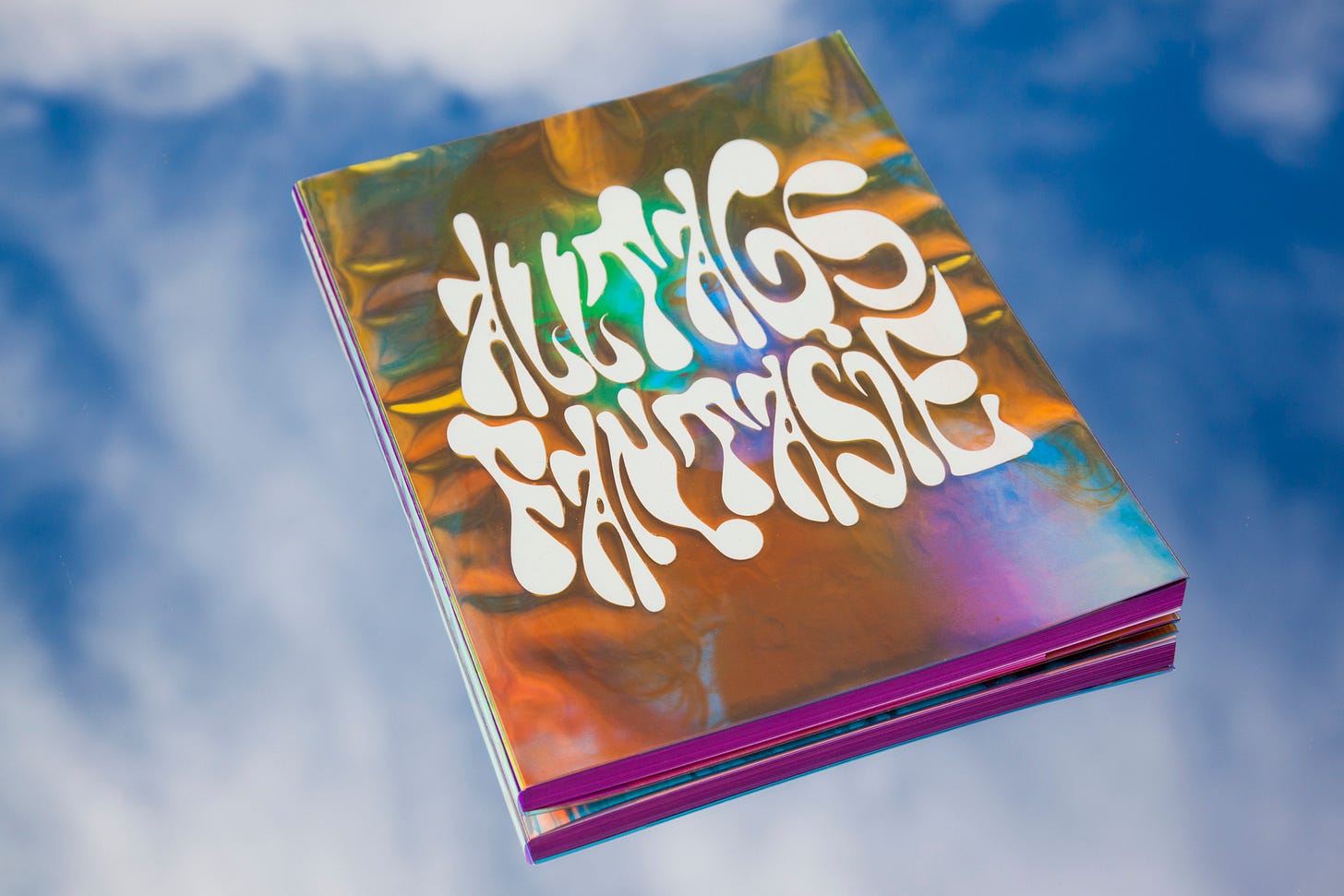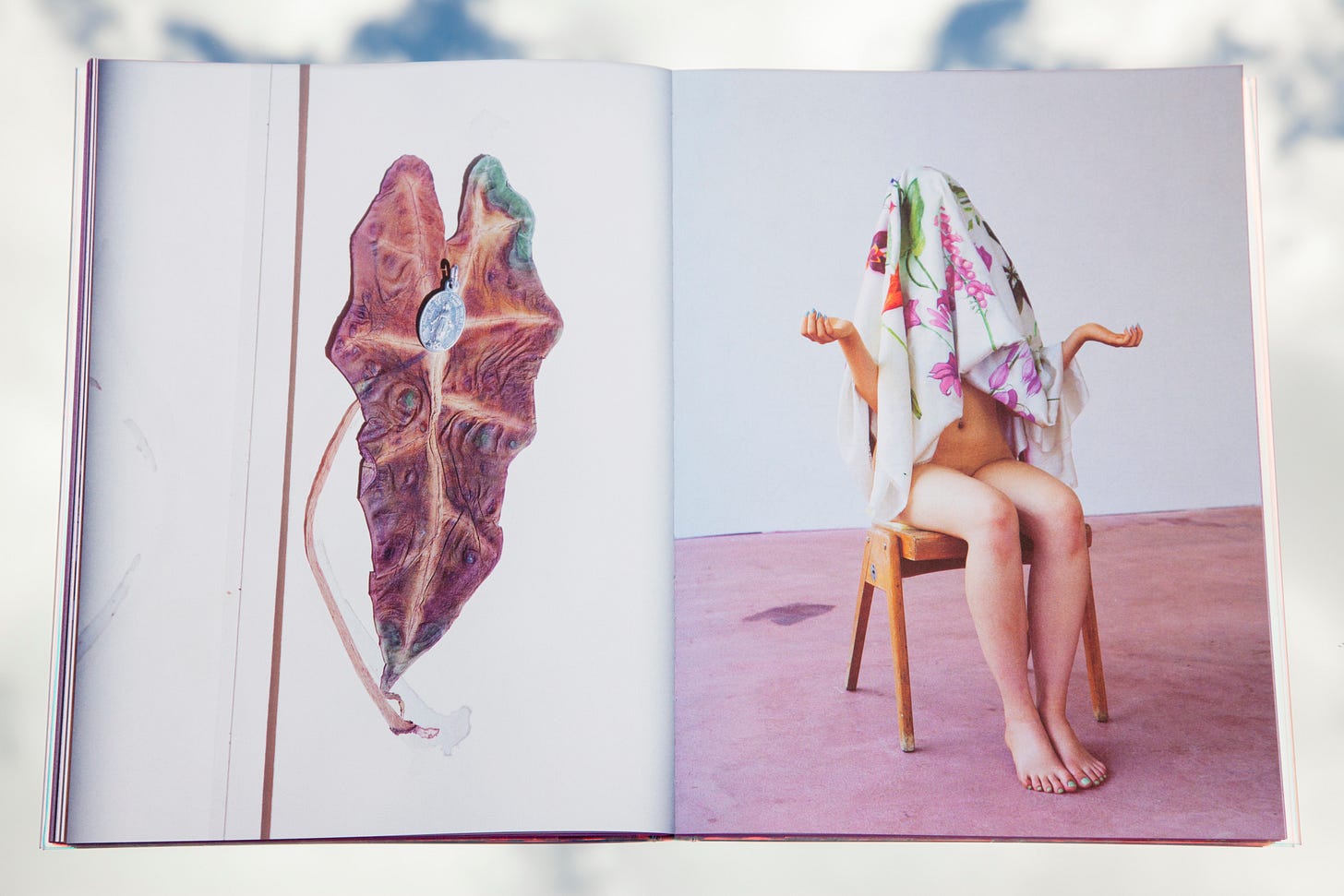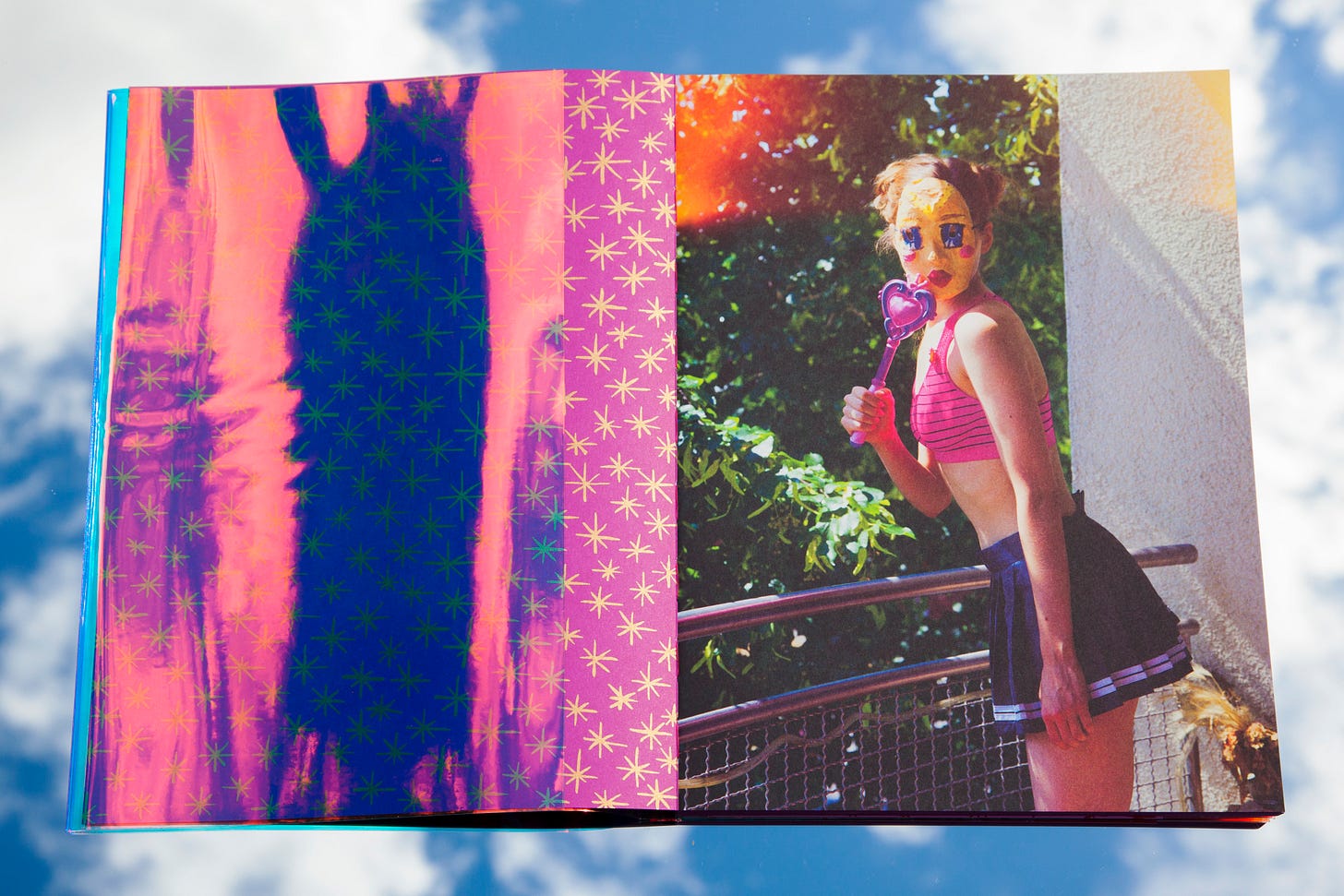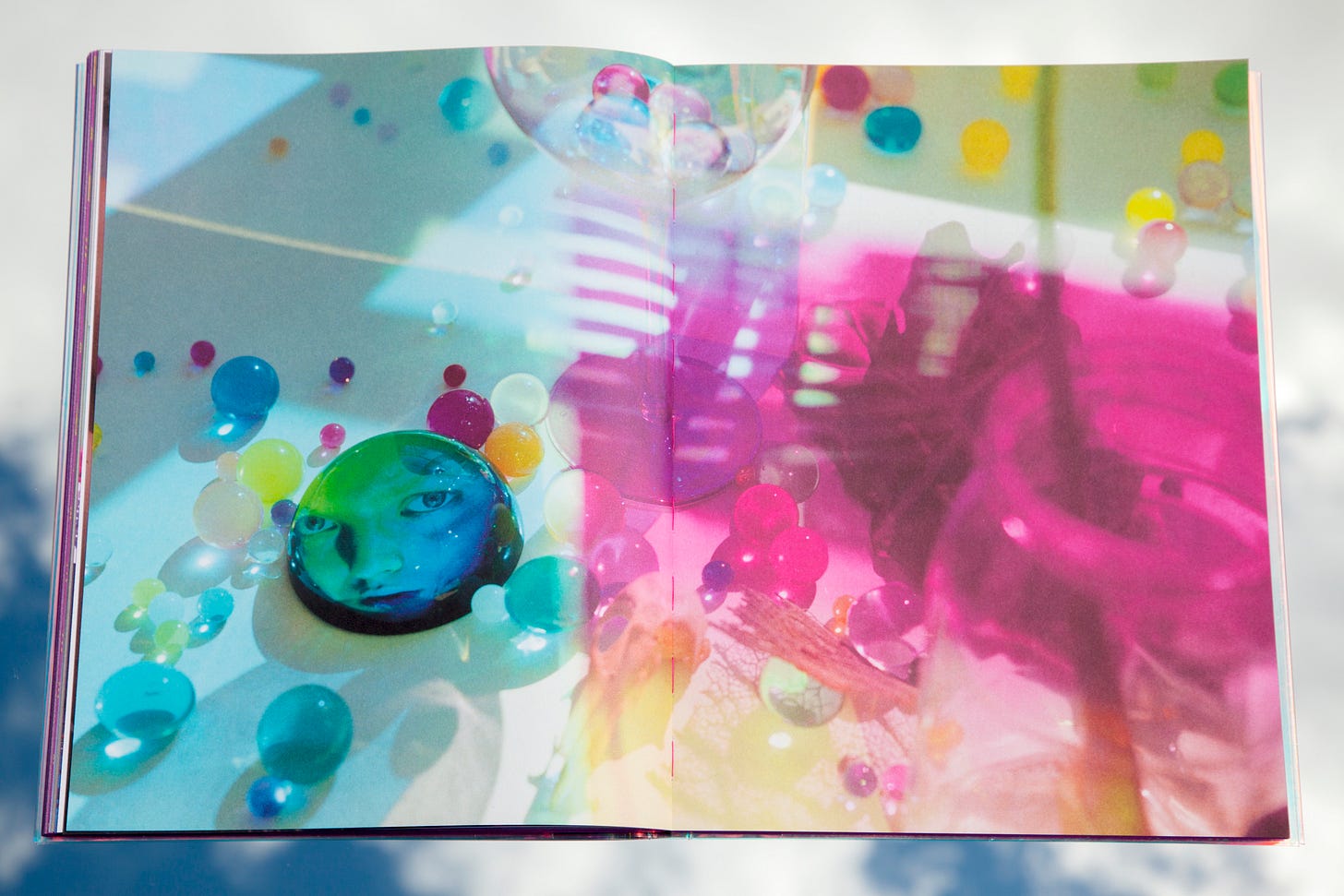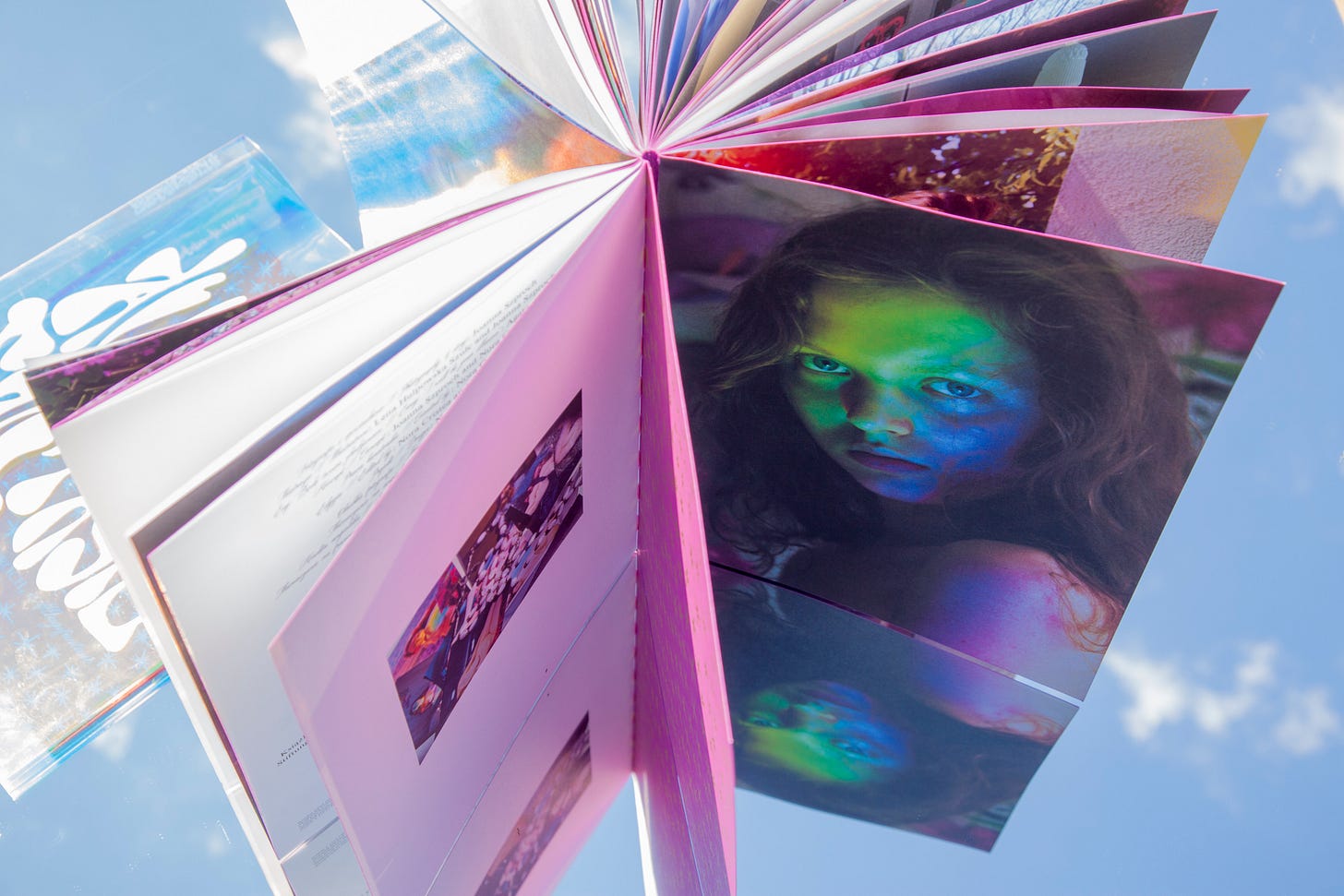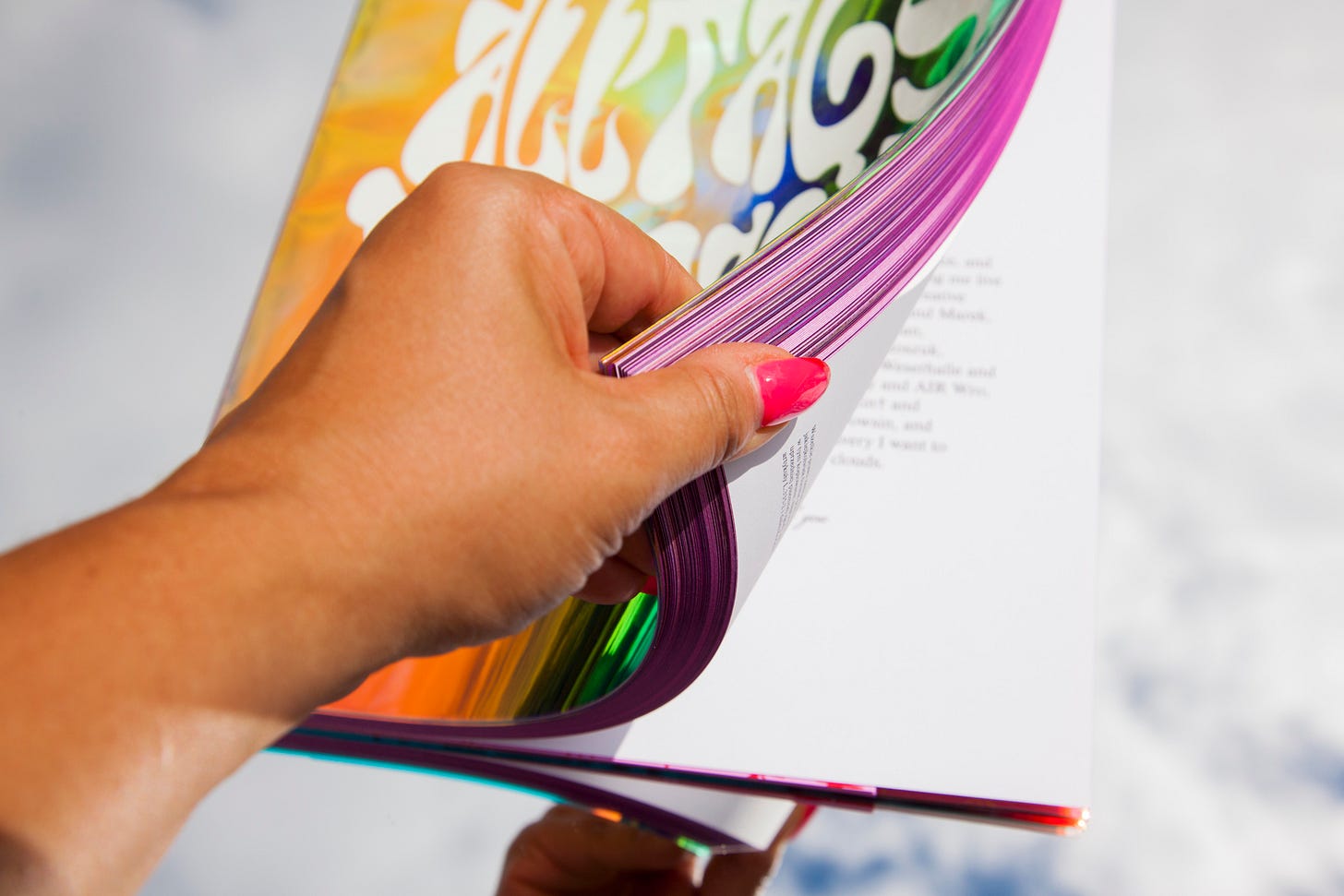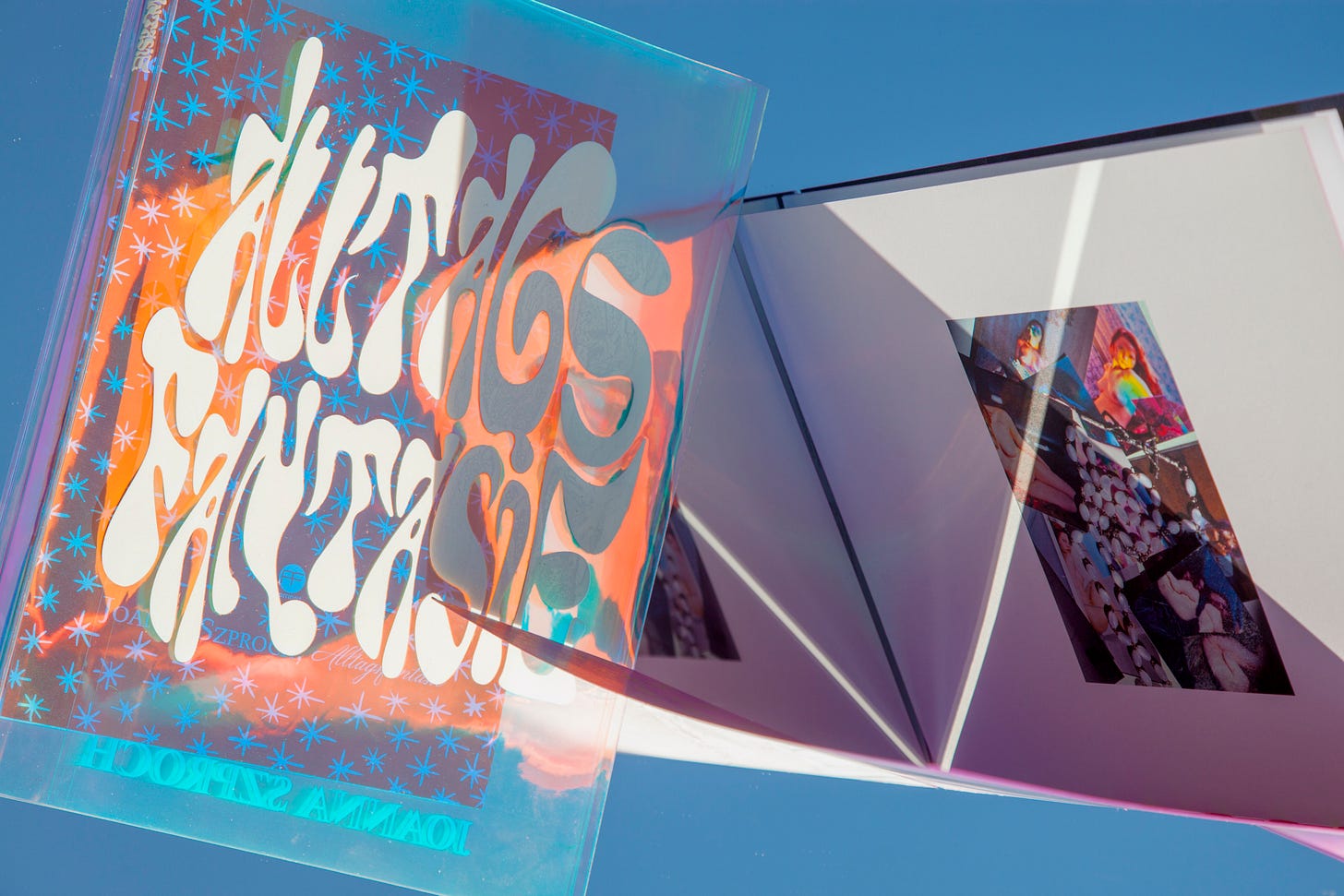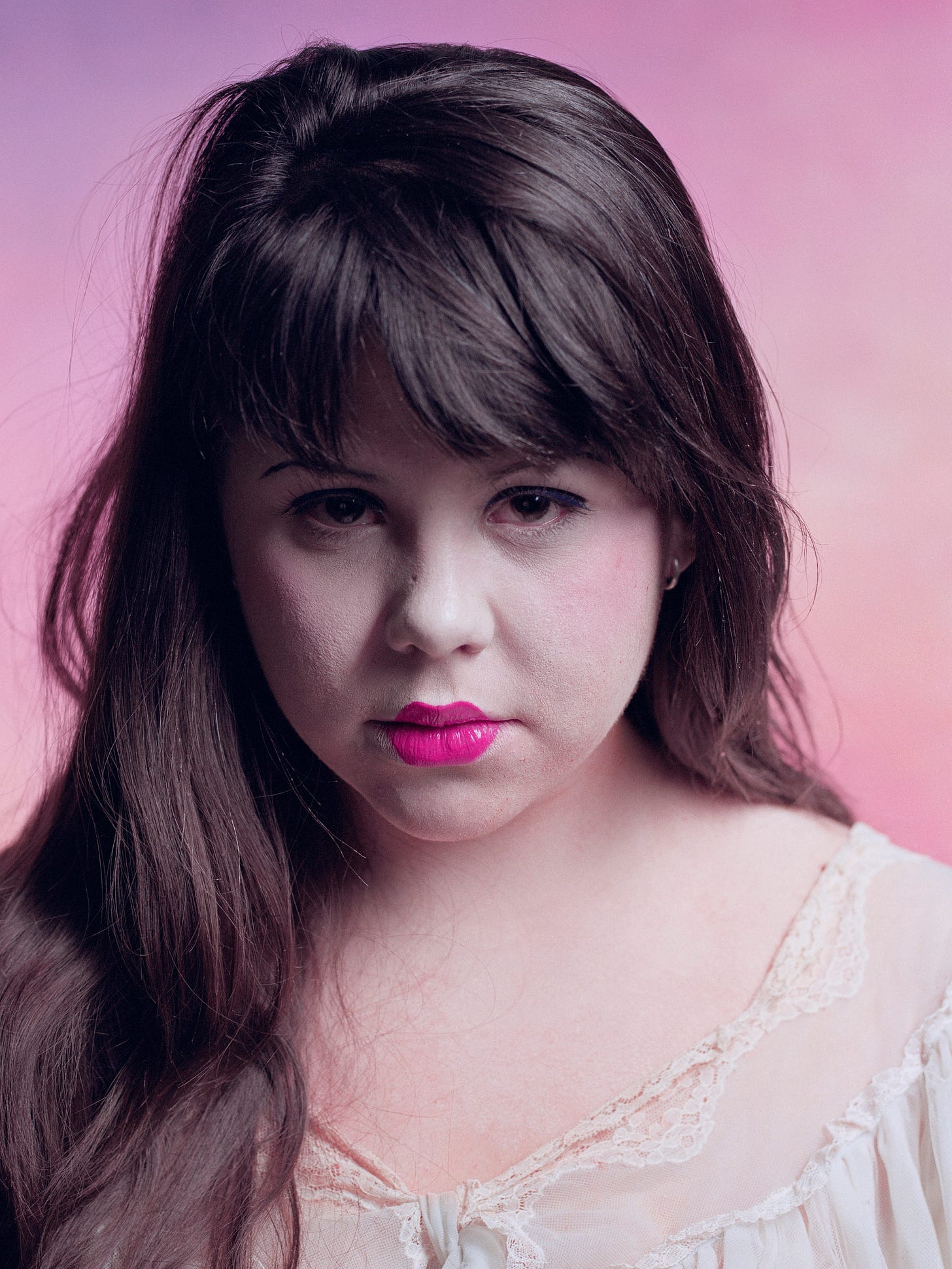Joanna Szproch interviewed by Lady Gaby about Alltagsfantasie - her debut artist photo book.
The script from the August Wordbank Radio Show.
Wordbank Radio Show by Lady Gaby
Gaby: Today, I'm excited to introduce our guest, Joanna Szproch, a photographer and visual artist originally from Poland and a long-time resident of Berlin. She has poured years of effort into her life's work, which has now been beautifully encapsulated in a book. This book is a vibrant, tactile masterpiece with a mirror-like cover that reflects its central theme. Inside, it's a fantastical journey featuring playful images drawn from childhood, her muse, self-portraits, along with family involvement, illustrations, and text. It's impeccably organized yet soft to the touch, radiating femininity and eye-catching brightness. This is not only a perfect art book but also an ideal coffee table addition. Welcome, Joanna! How are you today?
Joanna: Hey, I'm good.
Gaby: Congratulations on producing your book. You must be feeling amazing.
Joanna: I'm currently in the process of digesting everything, and it will take some more time. I had a pre-premiere at a photo festival in Arles, and the official launch is scheduled for September 16th in Berlin, which I'm very excited about. The book's creation was quite a journey, spanning many years, and it didn't feel like a single day could do justice to its release. The process of producing my first book was incredibly intense, given its complexity. I dedicated 13 years to its creation, making it a slow and significant work of art.
The process of producing my first book was incredibly intense, given its complexity. I dedicated 13 years to its creation, making it a slow and significant work of art.
Gaby: Indeed, it's been quite a journey spanning many years, and the book reflects a lot of personal growth. It's like a visual diary of your life, with portraits from your younger years, your daughter's presence through illustrations and text, as well as other family members and snippets from various places you've lived or visited. Could you share the title of the book with us?
Joanna: The title is Alltagsfantasie which means in English Everyday Fantasy. I think it fits everything because I just try to find significant things in everyday situations.
Gaby: I've looked through it, and it's stunning. It's visually captivating, bursting with various angles, subjects, backgrounds, and foregrounds. It's a unique, feminine, and some might say erotic or provocative work. I noticed there are many nude self-portraits in the book. Was it important for you to include these?
Joanna: Initially, I didn't plan for this project to become a book. It began with photographing a fashion model, someone initially anonymous but undeniably beautiful. She had a very slender figure, seemingly always on a diet. I saw in her the image of how I wished to be myself, and I wanted to photograph her, imagining her as me.
I saw in her the image of how I wished to be myself, and I wanted to photograph her, imagining her as me.
Gaby: Indeed, it's fascinating how our muses often represent an alter ego or something we aspire to be but can't. I've noticed that many of the photographs have an innocent yet provocative quality, reminiscent of a Lolita-like setting. Are you aware of this, and do you anticipate any potential backlash as a result?
Joanna: While I understand how some might perceive a Lolita-like quality from a male gaze perspective, my connection to sexuality is rooted in innocence. I believe the taboo around sex is what makes it seem dirty. My perspective on sex is innocent and girlish, but not like a “sexy teenager to fuck”.
While I understand how some might perceive a Lolita-like quality from a male gaze perspective, my connection to sexuality is rooted in innocence. I believe the taboo around sex is what makes it seem dirty. My perspective on sex is innocent and girlish, but not like a “sexy teenager to fuck”.
Over the years, this project evolved, and my muse and I grew together. She was recreating an alter ego representation of mine, but our relationship also influenced me. She shifted away from the modeling world due to dissatisfaction with its standards, which I found exploitative as well. I realized that I was using her, and I wanted our connection to be more equal. Patrycja, my muse, is close in age to my youngest sister, creating a sisterly bond between us. She introduced me to the cultural shifts in body positivity and feminism among the younger generation, which inspired me. I began photographing myself alongside her, marking a turning point in our journey. While the book isn't chronological due to its collage format, this was a pivotal moment. It helped me accept myself and view my body as a vessel for sensations and pleasure, rather than solely an object for others' impressions or seduction. Our bodies are places to experience the world and connect with it through our senses.
I began photographing myself alongside her, marking a turning point in our journey. While the book isn't chronological due to its collage format, this was a pivotal moment. It helped me accept myself and view my body as a vessel for sensations and pleasure, rather than solely an object for others' impressions or seduction. Our bodies are places to experience the world and connect with it through our senses.
Gaby: Your response is excellent, appreciating the book's exploration of diverse fantasies, female friendship, sisterhood, and the rejection of objectification. It applauds the book's portrayal of everyday moments, happiness, and the use of the body as an instrument of emotion and pleasure. It also addresses potential misinterpretations by some critics who may view it differently. As I said, it's stories, moments of happiness, sisterhood, of fantasy, and as you said, you're using your body as an avatar, for feelings, for pleasure, for emotions rather than objectified or to be owned by…
Joanna: …the society.
Gaby: I appreciated the inclusion of childhood photos, illustrations of manga characters, childlike drawings, and handwritten elements in your book. They convey a sense of innocence and charm through their pink, colorful imagery and collages. Additionally, the use of animals like snails, butterflies, peacocks, and chameleons caught my attention. Could you share your intention behind incorporating these elements and how they relate to the overall narrative or theme of the book?
Joanna: I included these elements to express innocence, my relation with nature, and its beauty. It's an intuitive representation of my perception and a way to bind with what I observe. This curiosity makes me feel more alive, and I see a feminine quality in nature – a connection, cooperation, and interdependence with all life entities, rather than ownership or conquest.
This curiosity makes me feel more alive, and I see a feminine quality in nature – a connection, cooperation, and interdependence with all life entities, rather than ownership or conquest.
Gaby: It's lovely to see how you've incorporated the female form, including yourself, your muse, and other characters, in such a setting with innocent, colorful animals and nature in your work. It creates a unique connection. I see how it reflects your artistic intent and signature. I'm curious, how did your daughter influence or inspire the creation of this book?
Joanna: Initially hesitant, I included her presence in my work, a recurring motif. I intended to explore the themes of motherhood and our unique relationship, recognizing their significance in shaping my identity as a mother and connecting them to the body that brought her into existence. I introduced her early illustrations, crafted when she was just nine years old, into the narrative. My archival research unveiled her innocent depictions of women, clearly influenced by my openness. It’s captivating to observe a nine-year-old’s art untainted by adult fetish, biases, or male projection.
I introduced her early illustrations, crafted when she was just nine years old, into the narrative. My archival research unveiled her innocent depictions of women, clearly influenced by my openness. It’s captivating to observe a nine-year-old’s art untainted by adult fetish, biases, or male projection.
Gaby: Would you say that this also, this book comes across to me, it's almost like looking through an innocent child, childlike mind, like the way you perceive the world. Would you say that about the book?
Joanna: Absolutely, I would. I hold our purity in high regard because it's our minds that pass judgment. We create these biases, compartmentalize everything, and suddenly, sex becomes a taboo subject primarily centered on power dynamics, often overshadowing genuine connection. To me, sex holds a sacred quality, and I aspire to reshape people's perspectives on it. It may not be the most central aspect of life for me, but what truly matters is dispelling the notion of sex as something dirty, as often portrayed in Abrahamic religions. We should move away from the idea that a woman must be submissive and treated as property, reinforcing male dominance.
We create these biases, compartmentalize everything, and suddenly, sex becomes a taboo subject primarily centered on power dynamics, often overshadowing genuine connection. To me, sex holds a sacred quality, and I aspire to reshape people's perspectives on it.
Gaby: All religions, no?
Joanna: Not all religions subscribe to this view. This further reinforces my belief that the notion of sex being inherently bad, dirty, or sinful is a construct of the human mind.
Not all religions subscribe to this view. This further reinforces my belief that the notion of sex being inherently bad, dirty, or sinful is a construct of the human mind.
Gaby: I found a captivating photo in the book featuring your grandma and her sister in a bath, radiating joy. While not explicit, you can see the cleavage and they're just like in the same bath together in your bathroom, it shows their happiness. Could you share your connection with them and what inspired you to choose that moment from your family archive?
Joanna: Because it's about sisterhood.
Gaby: All right. Okay. Sure.
Joanna: There are many layers to this, including the presence of demons, as sex and our bodies can sometimes lead us to become obsessed or passionate, even to the point of feeling demonic. I don't want to reveal too much; I prefer to leave this book open to various interpretations. What I can share is that behind closed doors in our house, things were often unconventional and defied societal norms and expectations, filled with fun and moments that might be seen as a bit crazy. As I worked on this book, I realized that I am a unique, queer extension of my conservative, eccentric family. They were unconventional but kept it hidden from the outside world. These unusual experiences shaped me, and I can't suppress them because it feels suffocating to keep them hidden.
As I worked on this book, I realized that I am a unique, queer extension of my conservative, eccentric family. They were unconventional but kept it hidden from the outside world. These unusual experiences shaped me, and I can't suppress them because it feels suffocating to keep them hidden.
Gaby: It's indeed a beautiful photo. I noticed that many of the characters or subjects in the photos were wearing masks. They weren't fetish masks; they had a childhood-like quality. Did you create these masks, or was it the idea of the models to wear them? Can you share the story behind the mask-wearing concept?
Joanna: The mask is a Sailor Moon mask, which my daughter made. My daughter got fascinated by Sailor Moon.
Gaby: That's a manga character, right?
Joanna: Yes, she's like Supergirl. My daughter got inspired by the character after my younger sister, who's 11 years younger. While I missed out on Sailor Moon, my sister watched it a lot as she was growing up, and I sometimes joined her, as I also played the role of her babysitter. Patrycja, my muse, is my sister's age, and she too was obsessed with Sailor Moon, akin to Supergirl. My daughter also embraced it, and they all loved it. My daughter created a mask, and we all wore them. It was a playful, spontaneous decision rather than a strict plan. I didn't intentionally incorporate symbols; it was more intuitive, like in dreams, shaped by associations and spontaneity.
My daughter created a mask, and we all wore them. It was a playful, spontaneous decision rather than a strict plan. I didn't intentionally incorporate symbols; it was more intuitive, like in dreams, shaped by associations and spontaneity.
Gaby: I completely agree with your interpretation. The whole book feels like a journey into childhood, exploring things through an innocent perspective in beautifully imaginative settings, like dreamlands. The inclusion of photos from fun parks adds to this sense of playful fantasy. It's as if you're revisiting these childhood dreams as an adult, with vibrant colors, symbols, and layers that delve into connections across generations. I appreciate your focus on desexualizing and de-fetishizing the female body and redeeming it in various body shapes. There's even a male partner, an ex-boyfriend, who transforms his persona with a manga wig, which adds a unique dimension. It's a deeply personal project, and while it's your book, would you say it's like your creative baby in pictures?
Joanna: I've been creating this work for over a decade, which has since been described as a multi-layered self-portrait by Agata Ciastoń, the curatorial text’s author in the book that also became an emblem for project communication. While it is indeed a self-portrait, it's not obvious, like photographing myself in a mirror. It's deeply personal and biographical but doesn't follow the formal documentary style; it's more of a performance. I hope that people can find something in it to which they can relate. I aimed to incorporate universal symbols that resonate with others on a subconscious level, emphasizing our interconnectedness.
While it is indeed a self-portrait, it's not obvious, like photographing myself in a mirror. It's deeply personal and biographical but doesn't follow the formal documentary style; it's more of a performance.
Gaby: Yes, I do hope the book appeals to people, and I'm pleased with how you turned some of your photographs into ready-made objects like the paperweight. Integrating your work into everyday life is something I find beautiful too. I'm open to exploring this further in the future. Are you potentially thinking of incorporating more of your photos into ready-made objects that can be used at home or in the office?
Joanna: In the final stages of creating the book, I delved into working on the text, which sparked a new interest in me. Writing applications for grants and such expanded my engagement with the text. The process of making the book was incredibly empowering, leading me to believe that there are no limits to art, and I can explore any medium I desire. I also have a background in violin, having studied it rigorously for eight years, so I possess some musical talents. While I'm uncertain about my next artistic steps, in the realm of photography, I'm inclined towards self-portraiture and performance, with a strong emphasis on authenticity, focusing on emotions and the soul. I'm intrigued by deconstructing the falsehoods and mental constructs we impose on ourselves, often to fit in or be accepted, which leads us away from our true selves.
I'm intrigued by deconstructing the falsehoods and mental constructs we impose on ourselves, often to fit in or be accepted, which leads us away from our true selves.
Regarding my technical approach, many of my photos are born from 3D collages constructed from layers of objects I randomly encounter in everyday situations. This is an area I'd like to explore further, possibly moving towards installations, performance art, and maybe even sound. When it comes to writing, my thoughts tend to flow rapidly, and I suspect I may be neurodivergent. I often write extensively, but I've challenged myself to be more concise. This practice not only benefits my creative work but also provides clarity in my everyday life. Due to my pronounced synesthetic tendencies, I'm eager to delve further into exploring combinations of text and sound, even though my primary experience of the world is as a "visual animal." The image remains central for me. My commitment to authenticity and radical honesty pushes me to step out of my comfort zone. I'm even contemplating a solo journey, as my daughter is now 20 and I have the freedom to travel more.
Due to my pronounced synesthetic tendencies, I'm eager to delve further into exploring combinations of text and sound, even though my primary experience of the world is as a "visual animal." The image remains central for me.
Gaby: You are free.
Joanna: I'm free. I did my duties already, you know, and sure she will for sure enjoy staying alone also.
Gaby: I hope you get the chance to travel more, especially after the book's release. I'd like to share an observation as well. Historically, photography like this was predominantly created by male photographers. I find it courageous the way you present yourself, your muse, and your family in these pictures in the book. Additionally, one image that struck me was a Polaroid where you confidently stood over three seated males while topless or naked, exuding self-assuredness and empowerment.
Joanna: I'm glad to clarify because there's a story behind that empowering-looking photo. It's part of a project by another artist duo, Ali Altin†, and Jochen Goerlach, and I included it in the book with their permission as part of a collage. Their project involved setting up a photo booth at various art events and parties where participants were asked to get naked and photographed with Polaroids. In return, everyone received a photo, and the rest were displayed in Aktfotofix shows.
I noticed it became a sort of trend in our circle to participate in this project, and it may have turned into a personal challenge for me. Perhaps there was some peer pressure, but I also wanted to prove to myself that if everyone could do it, so could I. It's worth mentioning that just two or three years earlier, I couldn't even feel comfortable in a swimsuit at the beach. So, when the photo was taken, I didn't genuinely feel empowered; it was more like faking it until I made it. They say you confront your traumas, expose yourself to them in a more friendly environment, and learn that it's not harmful at all; you can reprogram your thinking. It's all in our heads.
This moment was a turning point for me, pushing me out of my comfort zone. After processing it, I lost a lot of the shame I used to feel about my non-ideal body. It was a pivotal moment that made me feel much more at ease about exposing my nude body publicly, and I even started practicing FKK ( "free body culture") - though perhaps not in Poland.
This moment was a turning point for me, pushing me out of my comfort zone. After processing it, I lost a lot of the shame I used to feel about my non-ideal body. It was a pivotal moment that made me feel much more at ease about exposing my nude body publicly, and I even started practicing FKK ( "free body culture") - though perhaps not in Poland.
Gaby: For those who aren't familiar with the term, FKK stands for "Frei Körper Kultur," which translates to "free body culture." It involves activities like swimming, being in a forest, or at the beach while naked. This has been a symbol of freedom for many people, especially in East Germany and other parts of the country, particularly in Berlin. It's a significant cultural aspect in Germany, where you can enjoy activities like swimming naked in the forest, at lakes, or on specific nude beaches.
Joanna: And I find it fabulous that there are people of every age, sexual orientation, whatever. Yeah. Kids, old people, you know? And I love the idea because it's again, de-sexualization of the body like God made us, you know?
Gaby: That's right. So do you think that the fact you were born and raised in Poland, in Warsaw, has had a significant impact on this book? and the way you perceive yourself as an artist. Your cultural background, both from my family and your surroundings, has undoubtedly shaped your artistic perspective and the content of your work. Would you agree?
Joanna: I can't pinpoint exactly when my curiosity about "these" things (related to sex) began. It seems like I've always been intrigued by them. Around the age of 10, a friend and I drew a comic, including a sex scene (although we didn't understand what an erection was). While it might be normal to start being curious about sex at that age, I remember that we were bullied because of it. The drawing got out, and we faced public shame and stigma.
I can't pinpoint exactly when my curiosity about "these" things (related to sex) began. It seems like I've always been intrigued by them.
Another memory goes back to when I was 15 and attended a summer camp. At the end of the camp, every kid received a tag, and mine had something related to sex on it. So people have always associated me with sex, even though my family and parents are quite prudish and conservative. I was never allowed to witness even a kissing scene, even as a teenager. My dad would suddenly enter the TV room and turn off the TV when there was something "inappropriate" on. It felt like a form of censorship or forbidden fruit. Perhaps this is where my rebellious streak comes from, a reaction to parental censorship.
So people have always associated me with sex, even though my family and parents are quite prudish and conservative. I was never allowed to witness even a kissing scene, even as a teenager.
I've never believed that suppressing curiosity is the best approach, especially concerning sex. In my view, those who repress often become the most obsessed. I don't want to act as my psychoanalyst, but when it comes to sex, I consider myself sex-critical. I prefer meaningful, intimate connections over casual hookups. Trust and vulnerability are essential for a satisfying sexual experience, making it more than just a physical act. Quality sex requires losing self-consciousness, where I can let go of my ego and expose my naked self. However, this is my personal perspective.
I consider myself sex-critical. I prefer meaningful, intimate connections over casual hookups. Trust and vulnerability are essential for a satisfying sexual experience, making it more than just a physical act. Quality sex requires losing self-consciousness, where I can let go of my ego and expose my naked self. However, this is my personal preference.
Gaby: How do you think your book will be received in Poland? I, are you planning to sell it there?
Joanna: Sure. I, this is my mission actually like a Troyan horse.
Gaby: And so what do you think, what do you think their reactions will be, first of all, your family and secondly, the rest of the society there?
Joanna: To be honest, I don't plan to share the book with my family. My relationship with my parents is difficult. So they can maybe discover it themselves but on their responsibility. I don't care anymore how they would react to the book as they have a problem with accepting me in general. For most of my life, I felt guilty for not fulfilling their expectations, I believe they were embarrassed by me because of my interests, which they considered "filthy," especially for a girl or woman. Now I feel proud.
For most of my life, I felt guilty for not fulfilling their expectations, I believe they were embarrassed by me because of my interests, which they considered "filthy," especially for a girl or woman. Now I feel proud.
Gaby: Okay. And then the rest of the Polish people, what do you think?
Joanna: Because I think my parents represent half of Poland, I expect that the reception will be very polarized.
Gaby: But what do you think young women in Poland and the younger generation of people will accept it, will look at it and won't be, have the same conceptions or the same shock, or the same provocative thoughts as maybe their parents or their grandparents would.
Joanna: I don't believe my book is intentionally provocative. There have been far more provocative works created in the past. My intention is not to provoke, and I consider Poland to be a modern country with a rich culture. However, it's a country with deep divisions, and a significant portion of its culture has been influenced by Russia.
My intention is not to provoke, and I consider Poland to be a modern country with a rich culture. However, it's a country with deep divisions, and a significant portion of its culture has been influenced by Russia.
In Poland, I see religion more as a social concept rather than a spiritual one in most cases—it often appears quite superficial. What concerns me more, based on my observations during my visit to Poland last summer, is the emphasis on status and prestige in the country. This focus on social standing was one of the reasons I left my homeland. Poland is also quite monolithic, with people who haven't experienced much diversity, leading to xenophobia. Religiousness is just one facet of this issue.
Additionally, Poland is a very heteronormative society where women are expected to look good, not for themselves but for potential husbands or male partners. In contrast, men often don't prioritize their appearance because they don't have to. This patriarchal mindset still prevails. Women are expected to attract men and be chosen, as their value is often perceived as dependent on this. Men's entitlement persists, despite selfish motives, while women are expected to juggle attractiveness and caregiving, confined to nurturing roles. I don't harbor animosity toward men, but I despise this archaic imbalance. My book was created to promote reconciliation between the sexes and strive for more symmetry. In Poland, there remains a significant disparity in gender roles, with women still expected to be subservient to men. Much of this dynamic is rooted in the country's strong Catholicism. For some people in Poland, my book may indeed be shocking, but I can't change that.
Women are expected to attract men and be chosen, as their value is often perceived as dependent on this. Men's entitlement persists, despite selfish motives, while women are expected to juggle attractiveness and caregiving, confined to nurturing roles. I don't harbor animosity toward men, but I despise this archaic imbalance. My book was created to promote reconciliation between the sexes and strive for more symmetry.
Gaby: As an artist, your role is to express and share your perspective, and it's indeed up to each person to form their own opinions. I hope that many people who are against patriarchal norms will see your work differently and appreciate it for what it is. I encourage looking at it from a different perspective. It can make a unique and meaningful Christmas or birthday present. Even if some are initially shocked by the female nudity, playfulness, sexual posing, or erotic imagery in the book, that's okay. We are constantly surrounded by such images in advertising and other aspects of our daily lives.
Joanna: You make an interesting point. While we are exposed to sexual imagery in advertising, it's often used to sell products rather than promote open and honest discussions about sexuality. It's important to remember that everyone has either a vagina/vulva or a penis, and the majority of people engage in sexual activities. This should make discussions about sex and sexuality a natural and essential part of human life.
It's important to remember that everyone has either a vagina/vulva or a penis, and the majority of people engage in sexual activities. This should make discussions about sex and sexuality a natural and essential part of human life.
Gaby: Yeah. So, yeah. It's basically up to everyone. And, you know, your book is not judging everyone else, right?
Joanna: Indeed, people often tend to judge in order to assess situations. However, I firmly believe that individuals should have the freedom to make their own choices and live their lives as they wish, as long as they aren't causing harm to others. Respecting each other's autonomy and choices is an essential aspect of a diverse and inclusive society.
Respecting each other's autonomy and choices is an essential aspect of a diverse and inclusive society.
Gaby: I wanted to also ask about the text in the book. There's quite a lot of text spread throughout. There's a brochure at the end of it, also in Polish and German. What is the text saying?
Joanna: So there are two texts, One is handwritten and it's an impression of my daily impression from my diary: I just took a bath, read a book, and masturbated. I imagine what's going on in that book and everything is intertwined and yeah, it's kind of like everyday fantasy.
Gaby: So it's your personal story.
Joanna: That handwritten text is written by me.
Gaby: And what's the brochure at the end? That sort of extra layout thing that's pink and cute. What's that about? Is that from the curator or is that also yours?
Joanna: In the main book, there are two texts in Polish and English, one written by me and the other by curator Agata Ciastoń from Poland. Since the book is published by the French publisher Andre Frere Editions, we decided to translate it into French. Additionally, because the book was made possible thanks to German funding, I wanted to make it more accessible to a German-speaking audience as well. The book is available in four languages, with two languages in the main book and two more in an extra brochure. I want to express my heartfelt gratitude to Nora Cristea, my incredible Romanian witch-designer, who conjured this book into existence. Without her, this book simply wouldn't have happened. Our collaboration was fantastic, and we developed a strong connection, becoming friends in the process, often understanding each other without needing words.
I want to express my heartfelt gratitude to Nora Cristea, my incredible Romanian witch-designer, who conjured this book into existence. Without her, this book simply wouldn't have happened. Our collaboration was fantastic, and we developed a strong connection, becoming friends in the process, often understanding each other without needing words.
Gaby: Yes. That sounds beautiful. Also, I wanted to ask, how was the reception of the book at this book fair? You are at a photo festival in Arles, in France just recently. Tell me about that experience.
Joanna: Oh. Arles is the most recognized photo festival worldwide. It’s a photographic mecca. We had great success - the book was Andre’s best-seller without any publicity. We just produced the first batch of 50 copies a few days before the festival. People loved it so much - like it was selling by itself - a beautiful object.
Gaby: So you've sold quite a few copies already. That's fantastic. Well, that's great. That's awesome. Alltagsfantasie. That's fantastic! Concerning the process of becoming an artist, shifting from a photographer in the fashion industry to breaking away from that and creating something related to fashion, though not entirely fashion, but still focusing on bodies, looks, staging, and world-building.
Joanna: I would never reject that aspect because it can be so playful, and that's what fashion taught me - creating worlds. I'm not a photographer focused on factual and literal documentary. I prefer to express my truths by being authentic and showing my world, a fantastic reality that doesn't conform to normative language but instead utilizes performance and staging. It's about self-expression with a touch of fantasy, but it's also deeply biographical. I'm not sure if it fits neatly into any specific category.
I prefer to express my truths by being authentic and showing my world, a fantastic reality that doesn't conform to normative language but instead utilizes performance and staging. It's about self-expression with a touch of fantasy, but it's also deeply biographical. I'm not sure if it fits neatly into any specific category.
Gaby: It’s not my intent to put your work in a box. I'm just trying to comment on the fact that you started as a fashion photographer and now you're a fine art photographer or, as an artist, a photographer. Have any famous photographers have influenced you in the past or even now?
Joanna: Yes, that's correct. Thanks to the book, my work no longer fits the label of being just a photographer, which often falls under applied arts. I've found my artistic voice and now consider myself a visual artist. While I was influenced by many fashion photographers in the past, shaping my aesthetics, I've since shifted my focus. Some of my favorite photographers back then were Vivian Sassen and Harley Weir. However, I'm not as involved in the fashion photography world now, so I don't follow it closely. As my focus changed, I became more interested in photographers with a different approach, like Laia Abril. She's more of an artist with a journalist's approach, a history detective who deconstructs patriarchal myths using evidence. Her ongoing series, "A History of Misogyny," which includes books like "On Abortion" and, more recently, "On Rape," is remarkable for its subject matter and investigative approach.
As my focus changed, I became more interested in photographers with a different approach, like Laia Abril. She's more of an artist with a journalist's approach, a history detective who deconstructs patriarchal myths using evidence. Her ongoing series, "A History of Misogyny," which includes books like "On Abortion" and, more recently, "On Rape," is remarkable for its subject matter and investigative approach.
Gaby: And where is she from?
Joanna: Laia Abril is Spanish, and I had the opportunity to meet her in Arles, which was a highlight for me because I truly admire her and her work. She's my icon. While my book is quite different from her work, I think her method of working with archives inspired me to conduct my private investigation, delving deep into my memories to search for evidence of the past. Her working approach was an inspiration, even though the outcomes are vastly different. Her last book is in black and white, while mine is like a rainbow.
Her working approach was an inspiration, even though the outcomes are vastly different. Her last book is in black and white, while mine is like a rainbow.
Gaby: Is it possible that the vibrant colors in your book reflect a deeper message of diversity and tolerance, especially considering the anti-LGBTQ+ political climate in Poland and the symbolism associated with the rainbow? Do you think this choice of colorful imagery might have been influenced, even unconsciously, by the current situation and your desire to promote inclusivity?
Joanna: I view things as complex, reject black-and-white thinking, and identify as an anarchist. I see minority scapegoating as a political tool, fueled by powerful emotions that deflect from politicians' responsibility. I empathize with diverse groups, including women facing discrimination. I believe in unity among minorities, even if I'm unsure about certain issues, like trans and radical feminism. I recognize the influence of capitalism and the 1% benefiting from division. I advocate for non-violent, honest discussions, and oppose censorship, contempt, hate, and violence. This is my political stance, rooted in empathy for those facing discrimination due to their differences.
I advocate for non-violent, honest discussions, and oppose censorship, contempt, hate, and violence. This is my political stance, rooted in empathy for those facing discrimination due to their differences.
Gaby: Well we are coming to almost towards the end. Please tell me more about the launch of your beautiful book Alltagsfantasie on the 16th of September in Berlin and where people can get the book in the future after it's been released.
Joanna: The book will be available at the AP bookstore in Berlin-Wedding, as well as on my publisher's website and other bookstores in the future. The launch event on September 16th at 6 pm features curator Isabelle Meiffert hosting a discussion with me and the book's designer, Nora Cristea, starting at 7 pm. We also have merchandise, with proceeds supporting the LARA counseling center for victims of sexual assault and rape.
The book will be available at the AP bookstore in Berlin-Wedding, as well as on my publisher's website and other bookstores in the future. The launch event on September 16th at 6 pm features curator Isabelle Meiffert hosting a discussion with me and the book's designer, Nora Cristea, starting at 7 pm. We also have merchandise, with proceeds supporting the LARA counseling center for victims of sexual assault and rape.
Gaby: Wow. Fantastic. Very, very good cause, and let's hope that happens. Let's hope we raise a lot of money. I hope you'll sell a lot of books. I hope this book will be on everyone's coffee table or their bookshelves. Two more questions before I say goodbye. In one word, how do you describe your book?
Joanna: Self-Portrait? Is it one or two words (laugh)?
Gaby: And the last, last question of the show is if this book had a soundtrack, what would it be? Mm. What song?
Joanna: Oh. I love this song Unison by Björk - the lyrics and the video. It fits my definition of interdependency and how we need to stay within ourselves and still cherish each other in synergy.
Gaby: Thank you for the interview! To connect with Joanna, check out her Instagram and Facebook profiles, as well as her website. Her book is available for purchase at www, and it's an impressive, visually striking tome. The shiny mirror-like cover makes it stand out on any shelf and offers a unique self-reflective experience when you pick it up.
Joanna: And the title glows. The title is still screened on the wrap. Is glowing in the dark.
Hi, I am Joanna Szproch, a middle-aged woman, a mother of an adult daughter, and an empiricist, and thinker. I am from Generation X, I was born and lived in communist Poland, experienced its transformation, and more than a decade ago I left to become a Berlin resident. Here is where I create, teach, and explore the mystery of life. I launched this channel to share my subjective observations and conclusions, that may be right, or not. This may be a good background for understanding my artistic practice, a place for a dialog, or perhaps another beginning point for us to create something new. I have a deep need to share my position without proving it right and I will be glad if it resonates with you. If it doesn’t please don’t follow.





